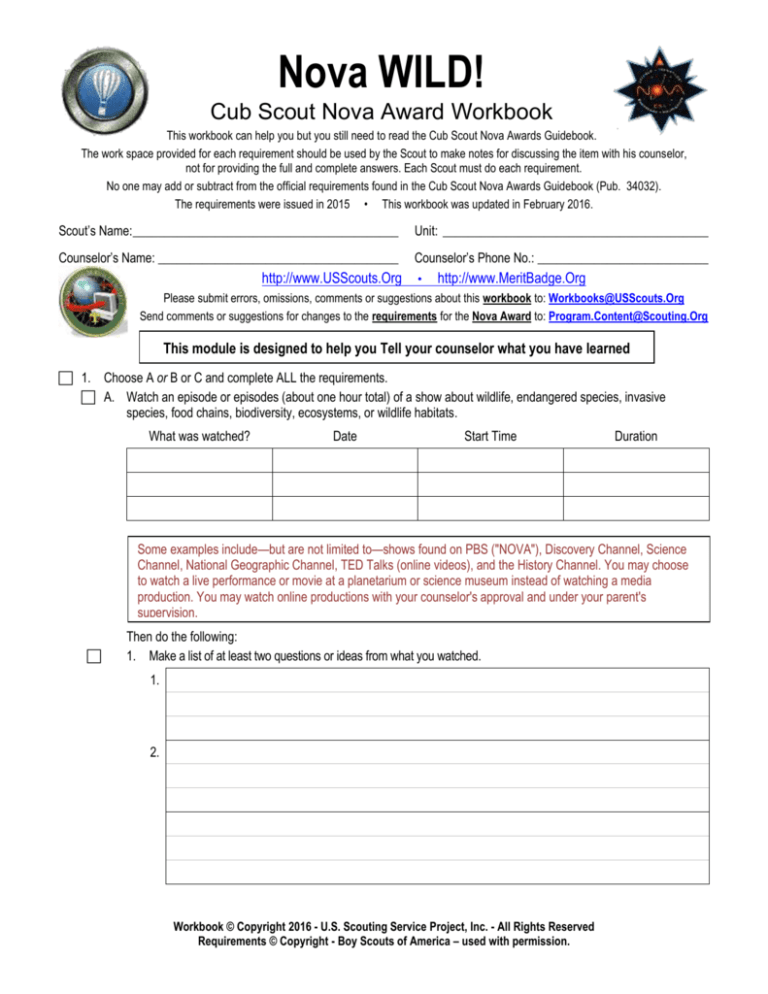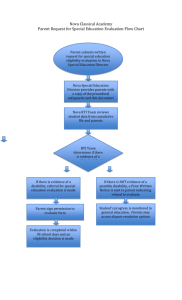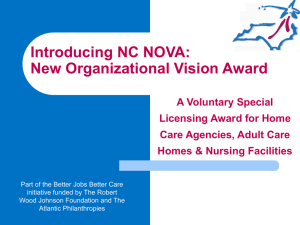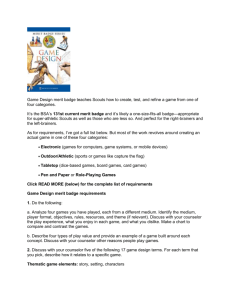
Nova WILD!
Cub Scout Nova Award Workbook
This workbook can help you but you still need to read the Cub Scout Nova Awards Guidebook.
The work space provided for each requirement should be used by the Scout to make notes for discussing the item with his counselor,
not for providing the full and complete answers. Each Scout must do each requirement.
No one may add or subtract from the official requirements found in the Cub Scout Nova Awards Guidebook (Pub. 34032).
The requirements were issued in 2015 • This workbook was updated in February 2016.
Scout’s Name:__________________________________________
Unit: __________________________________________
Counselor’s Name: ______________________________________
Counselor’s Phone No.: ___________________________
http://www.USScouts.Org
•
http://www.MeritBadge.Org
Please submit errors, omissions, comments or suggestions about this workbook to: Workbooks@USScouts.Org
Send comments or suggestions for changes to the requirements for the Nova Award to: Program.Content@Scouting.Org
This module is designed to help you Tell your counselor what you have learned
about space exploration while working on this award.
1. Choose A or B or C and complete ALL the requirements.
A. Watch an episode or episodes (about one hour total) of a show about wildlife, endangered species, invasive
species, food chains, biodiversity, ecosystems, or wildlife habitats.
What was watched?
Date
Start Time
Duration
Some examples include—but are not limited to—shows found on PBS ("NOVA"), Discovery Channel, Science
Channel, National Geographic Channel, TED Talks (online videos), and the History Channel. You may choose
to watch a live performance or movie at a planetarium or science museum instead of watching a media
production. You may watch online productions with your counselor's approval and under your parent's
supervision.
Then do the following:
1. Make a list of at least two questions or ideas from what you watched.
1.
2.
Workbook © Copyright 2016 - U.S. Scouting Service Project, Inc. - All Rights Reserved
Requirements © Copyright - Boy Scouts of America – used with permission.
Nova WILD!
Scout's Name: ________________________
2. Discuss two of the questions or ideas with your counselor.
1.
2.
B. Read (about one hour total) about wildlife, endangered species, invasive species, food chains, biodiversity,
ecosystems, or wildlife habitats.
What was read?
Date
Start Time
Duration
Books on many topics may be found at your local library. Examples of magazines include but are not
limited to Odyssey, KIDS DISCOVER, National Geographic Kids, Highlights, and OWL or owlkids.com.
Then do the following:
1. Make a list of at least two questions or ideas from what you read.
1.
2.
Nova WILD! – Nova Award Workbook
Page 2 of 15
Nova WILD!
Scout's Name: ________________________
2. Discuss two of the questions or ideas with your counselor.
1.
2.
C
Do a combination of reading and watching (about one hour total) about wildlife, endangered species, invasive
species, food chains, biodiversity, ecosystems, or wildlife habitats.
What was watched or read?
Date
Start Time
Duration
Then do the following:
1. Make a list of at least two questions or ideas from what you read and watched.
1.
2.
Nova WILD! – Nova Award Workbook
Page 3 of 15
Nova WILD!
Scout's Name: ________________________
2. Discuss two of the questions or ideas with your counselor.
1.
2.
2. Complete ONE adventure from the following list. (Choose one that you have not already earned.) Discuss with your
counselor what kind of science, technology, engineering, or math was used in the adventure.
Wolf Cub Scouts
Bear Cub Scouts
Webelos Scouts
Digging in the Past
A Bear Goes Fishing
Into the Wild
Grow Something
Critter Care
Into the Woods
Spirit of the Water
Nova WILD! – Nova Award Workbook
Page 4 of 15
Nova WILD!
Scout's Name: ________________________
3. Explore
A. What is wildlife? Wildlife refers to animals that are not normally domesticated (raised by humans).
B. Explain the relationships among producer, prey, predator, and food chain. (You may draw and label a food chain to
help you answer this question.)
Nova WILD! – Nova Award Workbook
Page 5 of 15
Nova WILD!
Scout's Name: ________________________
C. Draw (or find) pictures of your favorite native plant, native reptile or fish, native bird, and native mammal that live in
an ecosystem near you.
Why do you like these? How do they fit into the ecosystem?
D. Discuss what you have learned with your counselor.
Nova WILD! – Nova Award Workbook
Page 6 of 15
Nova WILD!
Scout's Name: ________________________
4. Act like a naturalist. Choose TWO from A or B or C or D or E or F, and complete ALL the requirements for those options.
A. Investigate the endangered species in your state.
1. Make a list, drawing, or photo collection of three to five animals and plants that are endangered.
1.
2.
3.
4.
5.
2. Design a display (a poster, PowerPoint presentation, or other type of display) to show at least 10 of the
threatened, endangered, or extinct species in your state. (You may use your drawings or photo collection in
your display.)
1.
6.
2.
7.
3.
8.
4.
9.
5.
10.
Nova WILD! – Nova Award Workbook
Page 7 of 15
Nova WILD!
Scout's Name: ________________________
3. Discuss with your counselor the differences between threatened, endangered, and extinct species.
Discuss how threatened animals or plants could become endangered or extinct.
How might the loss of these animals or plants affect the ecosystem and food chain?
Nova WILD! – Nova Award Workbook
Page 8 of 15
Nova WILD!
Scout's Name: ________________________
What can be done to preserve these species?
B. Investigate invasive species.
1. Make a list, drawing, or photo collection of at least five mammals, plants, fish, birds, insects, or any other
organisms that are invasive in your state or region of the country.
1.
2.
3.
4.
5.
Nova WILD! – Nova Award Workbook
Page 9 of 15
Nova WILD!
Scout's Name: ________________________
2. Design a presentation (a poster, PowerPoint presentation, or other display) including at least one of the invasive
species from your list.
Explain where they came from, how they got to your area, what damage they are causing, and what is being
done to get rid of them. Share your presentation with your counselor and your family or your den.
3. Discuss with your counselor what an invasive species is, how invasive animals or plants cause problems for
native species, and how these invasive species could affect an ecosystem and food chain.
Nova WILD! – Nova Award Workbook
Page 10 of 15
Nova WILD!
Scout's Name: ________________________
C. Visit an ecosystem near where you live.
1. Investigate the types of animals and plants that live in that ecosystem.
2. Draw a food web of the animals and plants that live in this ecosystem. Mark the herbivores, omnivores, and
carnivores. Include at least one decomposer or scavenger.
3. Discuss with your counselor (using your food web drawing) how the animals or plants in the food web fit into a
food chain. Which animals are predators and which can be prey? How does each plant and animal obtain its
energy? Describe the energy source for all the plants and animals.
D. Investigate one wild mammal, bird, fish, or reptile that lives near you.
1. Create a diorama representing the habitat of this creature. Include representations of everything it needs to
survive; its home, nest, or den; and possible threats. You may use a variety of different materials within your
diorama (usually constructed in a shoebox or similar container)..
2. Explain to your counselor what your animal must have in its habitat in order to survive.
Nova WILD! – Nova Award Workbook
Page 11 of 15
Nova WILD!
Scout's Name: ________________________
E. Investigate your wild neighbors.
1. Make a bird feeder and set it up in a place where you may observe visitors. The feeder could be complex or as
simple as a pinecone covered with peanut butter and rolled in birdseed and then tied with a string to an
appropriate location, like a tree branch.
2. Fill the feeder with birdseed. (Make sure that your feeder does not remain empty once you have started feeding
birds.)
3. Provide a source of water.
4. Watch and record the visitors to your feeder for two or three weeks. (It may take a while for visitors to discover
your food source.)
5. Identify your visitors using a field guide, and keep a list of what visits your feeder. (Visitors are not always birds!
Sometimes deer, rabbits, chipmunks, squirrels, and raccoons visit bird feeders—or the area under the feeder!
The kinds of nonbird visitors will depend on where you live. You may want to investigate how to collect the
tracks of any nighttime visitors.)
6. Discuss with your counselor what you learned about your wild neighbors.
Nova WILD! – Nova Award Workbook
Page 12 of 15
Nova WILD!
Scout's Name: ________________________
F. Earn the Cub Scout Outdoor Ethics Awareness Award OR the Cub Scout World Conservation Award (if you have
not already earned them for another Nova award)..
5. Visit a place where you can observe wildlife. Examples include parks (national, state, and local), zoos, wetlands, nature
preserves, and national forests.
A. During or after your visit, talk to someone about:
1. The native species, invasive species, and endangered or threatened species that live there. If you visit a zoo,
talk to someone about the ecosystems for different zoo animals and whether any of the zoo animals are
invasive in different areas of the world. (For example, pythons are often found in zoos, but they are an invasive
species in Florida.)
2. The subjects studied in school that enable him or her to work with wildlife. Examples of experts to talk to include
forest ranger, wildlife biologist, botanist, park ranger, naturalist, game warden, zookeeper, docent, or another
adult whose career involves wildlife.
B. Discuss with your counselor what you learned during your visit.
6. Discuss with your counselor:
A. Why wildlife is important.
Nova WILD! – Nova Award Workbook
Page 13 of 15
Nova WILD!
Scout's Name: ________________________
B. Why biodiversity is important.
C. The problems with invasive species and habitat destruction.
Nova WILD! – Nova Award Workbook
Page 14 of 15
Important excerpts from the Guide To Advancement - 2015, No. 33088 (SKU-620573)
[1.0.0.0] — Introduction
The current edition of the Guide to Advancement is the official source for administering advancement in all Boy Scouts of America programs: Cub Scouting, Boy
Scouting, Varsity Scouting, Venturing, and Sea Scouts. It replaces any previous BSA advancement manuals and previous editions of the Guide to Advancement.
[Page 2, and 5.0.1.4] — Policy on Unauthorized Changes to Advancement Program
No council, committee, district, unit, or individual has the authority to add to, or subtract from, advancement requirements. There are limited exceptions
relating only to youth members with special needs. For details see section 10, “Advancement for Members With Special Needs”.
[Page 2] — The “Guide to Safe Scouting” Applies
Policies and procedures outlined in the Guide to Safe Scouting, No. 34416, apply to all BSA activities, including those related to advancement and Eagle Scout
service projects.
[7.0.3.1] — The Buddy System and Certifying Completion
A youth member must not meet one-on-one with an adult. Sessions with counselors must take place where others can view the interaction, or the Scout must have a
buddy: a friend, parent, guardian, brother, sister, or other relative—or better yet, another Scout working on the same badge—along with him attending the session. If
merit badge counseling or instruction includes any Web-based interaction, it must be conducted in accordance with the BSA Social Media Guidelines
(http://www.scouting.org/Marketing/Resources/SocialMedia). For example, always copy one or more authorized adults on email messages between counselors and
Scouts.
When the Scout meets with the counselor, he should bring any required projects. If these cannot be transported, he should present evidence, such as photographs or
adult verification. His unit leader, for example, might state that a satisfactory bridge or tower has been built for the Pioneering merit badge, or that meals were
prepared for Cooking. If there are questions that requirements were met, a counselor may confirm with adults involved. Once satisfied, the counselor signs the blue
card using the date upon which the Scout completed the requirements, or in the case of partials, initials the individual requirements passed.
Note that from time to time, it may be appropriate for a requirement that has been met for one badge to also count for another. See “Fulfilling More Than One
Requirement With a Single Activity,” 4.2.3.6.
[7.0.3.2] — Group Instruction
It is acceptable—and sometimes desirable—for merit badges to be taught in group settings. This often occurs at camp and merit badge midways, fairs, clinics, or
similar events. Interactive group discussions can support learning. The method can also be attractive to “guest experts” assisting registered and approved
counselors. Slide shows, skits, demonstrations, panels, and various other techniques can also be employed, but as any teacher can attest, not everyone will learn all
the material.
There must be attention to each individual’s projects and his fulfillment of all requirements. We must know that every Scout —actually and personally— completed
them. If, for example, a requirement uses words like “show,” “demonstrate,” or “discuss,” then every Scout must do that. It is unacceptable to award badges on the
basis of sitting in classrooms watching demonstrations, or remaining silent during discussions.
It is sometimes reported that Scouts who have received merit badges through group instructional settings have not fulfilled all the requirements. To offer a quality
merit badge program, council and district advancement committees should ensure the following are in place for all group instructional events.
A culture is established for merit badge group instructional events that partial completions are acceptable expected results.
A guide or information sheet is distributed in advance of events that promotes the acceptability of partials, explains how merit badges can be finished after
events, lists merit badge prerequisites, and provides other helpful information that will establish realistic expectations for the number of merit badges that can be
earned at an event.
Merit badge counselors are known to be registered and approved.
Any guest experts or guest speakers, or others assisting who are not registered and approved as merit badge counselors, do not accept the responsibilities of,
or behave as, merit badge counselors, either at a group instructional event or at any other time. Their service is temporary, not ongoing.
Counselors agree to sign off only requirements that Scouts have actually and personally completed.
Counselors agree not to assume prerequisites have been completed without some level of evidence that the work has been done. Pictures and letters from
other merit badge counselors or unit leaders are the best form of prerequisite documentation when the actual work done cannot be brought to the camp or site
of the merit badge event.
There is a mechanism for unit leaders or others to report concerns to a council advancement committee on summer camp merit badge programs, group
instructional events, and any other merit badge counseling issues—especially in instances where it is believed BSA procedures are not followed. See
“Reporting Merit Badge Counseling Concerns,” 11.1.0.0.
There must be attention to each individual’s projects and his fulfillment of all requirements. We must know that every Scout—actually and personally—
completed them.
It is permissible for guest speakers, guest experts, or others who are not merit badge counselors to assist in the counseling process. Those providing such
assistance must be under the direction of a registered and approved counselor who is readily available onsite, and provides personal supervision to assure all
applicable BSA policies and procedures—including those related to BSA Youth Protection—are in place and followed.
[7.0.3.3] — Partial Completions
A Scout need not pass all the requirements of one merit badge with the same counselor. It may be that due to timing or location issues, etc., he must meet with a
different counselor to finish the badge. The Application for Merit Badge has a place to record what has been finished—a “partial.” In the center section on the reverse
of the blue card, the counselor initials for each requirement passed. In the case of a partial completion, the counselor does not retain his or her portion of the card. A
subsequent counselor may choose not to accept partial work, but this should be rare. A Scout, if he believes he is being treated unfairly, may work with his unit leader
to find another counselor. An example for the use of a signed partial would be to take it to camp as proof of prerequisites. Partials have no expiration except the
Scout’s 18th birthday. Units, districts, or councils shall not establish other expiration dates for partial merit badges.
[7.0.4.8] — Unofficial Worksheets and Learning Aids
Worksheets and other materials that may be of assistance in earning merit badges are available from a variety of places including unofficial sources on the Internet
and even troop libraries. Use of these aids is permissible as long as the materials can be correlated with the current requirements that Scouts must fulfill. Completing
“worksheets” may suffice where a requirement calls for something in writing, but this would not work for a requirement where the Scout must discuss, tell, show, or
demonstrate, etc. Note that Scouts shall not be required to use these learning aids in order to complete a merit badge.







